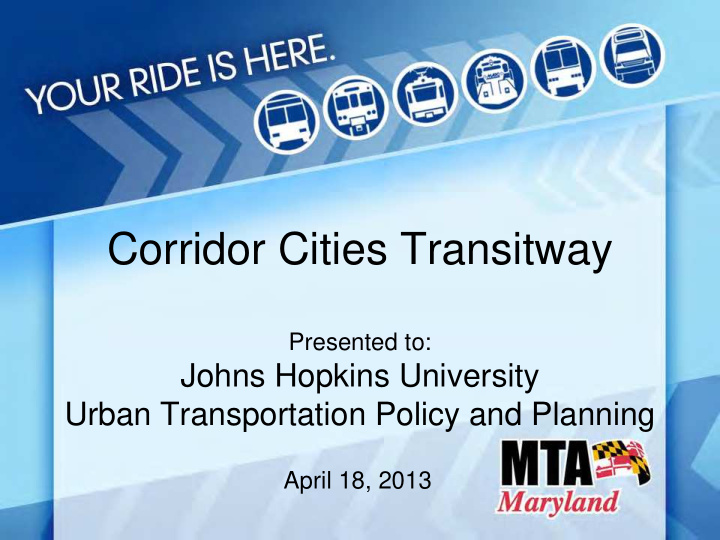



Corridor Cities Transitway Presented to: Johns Hopkins University Urban Transportation Policy and Planning April 18, 2013
Introduction • Consultant Project Team – Kyle Kramer, AECOM • Stations Architecture and Urban Design Manager – RK&K – Parsons Brinkerhoff
Agenda • Brief Project History • Current Project Status & Schedule • BRT & CCT Uniqueness • Project Challenges & Impacts
Project History • SHA I-270 Widening Studies – Variety of SHA PMs • I-270/US 15 Multi-Modal Corridor Study – Highway Needs too great – Inclusion of the Corridor Cities Transitway
CCT Project Timeline • May 2002: I-270/US 15 Multi-Modal Corridor Study DEIS and Section 4(f) Evaluation • May 2009: I-270/US 15 Multi-Modal Corridor Study Environmental Assessment/Alternatives Analysis • November 2010: Corridor Cities Transitway Supplemental Environmental Assessment • December 12, 2011: Independent Utility submitted • May 2012: Governor O’Malley announces the Locally Preferred Alternative
Study Area NORTHERN STUDY LIMIT: NORTHERN STUDY LIMIT: • Multi-Modal Study by SHA Biggs Ford Road Biggs Ford Road and MTA for MDOT • Project Team with SHA, MTA, Counties and Cities • 30 +/- miles of Limited Access Highway • 1.5 miles of New Alignment Highway (MD 75) SOUTHERN STUDY LIMIT: SOUTHERN STUDY LIMIT: Shady Grove Road Shady Grove Road • 14 +/- mile Transitway
CCT Alignment • Alignment established by Montgomery County in 1970s/1980s • Adopted in Master Plans in the 1990s • “Corridor Cities” • Targeted Growth Areas • Exclusive Right-of-Way • Light Rail Transit or Bus Rapid Transit
Great Seneca Science Corridor Master Plan (formerly Gaithersburg West Master Plan) • M-NCPPC – Montgomery County Planning Department • Does not include Cities of Rockville and Gaithersburg • Alignment options in three areas
SEA Alternative Alignments • Crown Farm, Shady Grove Life Sciences Center/Belward Farm, and Kentlands
Independent Utility • Transit Only • Full highway improvements by 2030 not feasible • Highway and transit on separate schedules – Highway: Break-out projects, Tiered FEIS approach, No funding or political will – Transit: Evaluation of Alternative Alignments, Locally Preferred Alternative (LPA) selection, Federal Transit Administration (FTA) New Starts Program 10
Locally Preferred Alternative • Governor O’Malley: May 11, 2012 • Mode: Bus Rapid Transit – 2 lanes – Exclusive guideway – Hiker/biker trail • 16 mile alignment – Shady Grove to Metropolitan Grove (9 mile Phase I) • Maintenance Facility: Near Metropolitan Grove • Phased Development and Construction
CCT LPA (cont.) Phase I Only Full Project Route Description Metropolitan Grove to COMSAT to Shady Shady Grove Grove Distance 9 miles 15 miles Stations 12 16 Travel Time 33 minutes 49 minutes Capital Cost $545 million (2012 $) $828 million (2012 $) Average Daily Riders 35,900 (2035) 56,400 (2035)
Schedule • Fall 2012 - Letter of Introduction to FTA • Winter 2012/13 - Approval to begin Project Development • Fall 2014 – Complete Preliminary Engineering and Final Environmental Document • Winter 2014/15 – Approval to begin Engineering • Summer 2017 – Receive Full Funding Grant Agreement • Summer 2017 – Begin Right-of Way Acquisition/Permitting/ Agreements • Fall 2018 – Begin Construction • 2020 – Begin Service
What is BRT? •LRT on Rubber Tires •Modern, low floor vehicles •Multiple door entry •Advanced fare payment •Varied runningways •Stations •Signal priority/premption •Real-time transit info • High frequency service •Operates on intervals, not a timetable •Branded – recognizable and distinct
What is Unique About CCT? • Premium BRT – First BRT project in Maryland – 36,000 daily riders, comparable to LRT – Premium service – • Exclusive guideway • Grade separation where warranted • High frequency – Flexibility for service options, extensions, coordination to existing bus services.
What is Unique About CCT? • Designed for future development, not around existing development – Most stations are at undeveloped places or places where redevelopment is anticipated. – Contrasts with theory that BRT is not attractive to developers – Project has evolved as development plans have evolved – Markets have changed over time – ROW set aside; “traditional” impacts are very few – Difficult for communities to envision, grasp and embrace
Project Challenges • Operations Planning – 36,000 riders challenging to serve with BRT – 60 foot vehicles; peak load of 1.5 or 90 passengers a vehicle – Headways (frequencies) could be 3 minutes or less during peak hours • Terminal Station Design – Shady Grove capacity – Metropolitan Grove circulation / coordination • Traffic Management • Design coordination with developers, local government, SHA and CSX • Community Acceptance and Ownership
Design Focus Areas • Alignment Review and Modifications • Utility Identification – Test pits • Storm Water Management – Integration of MDE requirements from the start • Traffic Analysis – VISSIM – Conflicts and crossings – Signal requirements
Design Focus Areas (cont.) • Structural Evaluation – Bridges – Underpasses – Retaining Walls • Stations – Conceptual Design – Surface and Aerial • Side or center platforms • Stormwater Management – Terminal Station Operations and Design • O&M Site design
King Farm Today
King Farm Renderings King Farm Station – Side Platform
King Farm Renderings King Farm Station – Center Platform
Crown Farm
Crown Farm Renderings
Crown Farm Renderings
Kentlands Station Renderings Kentlands Station
Kentlands Station Renderings Kentlands Station
Metropolitan Grove Today
Metropolitan Grove
Thank You •Kyle Kramer, AECOM •410-637-1734 •Kyle.Kramer@aecom.com www.mta.maryland.gov/cct
Recommend
More recommend